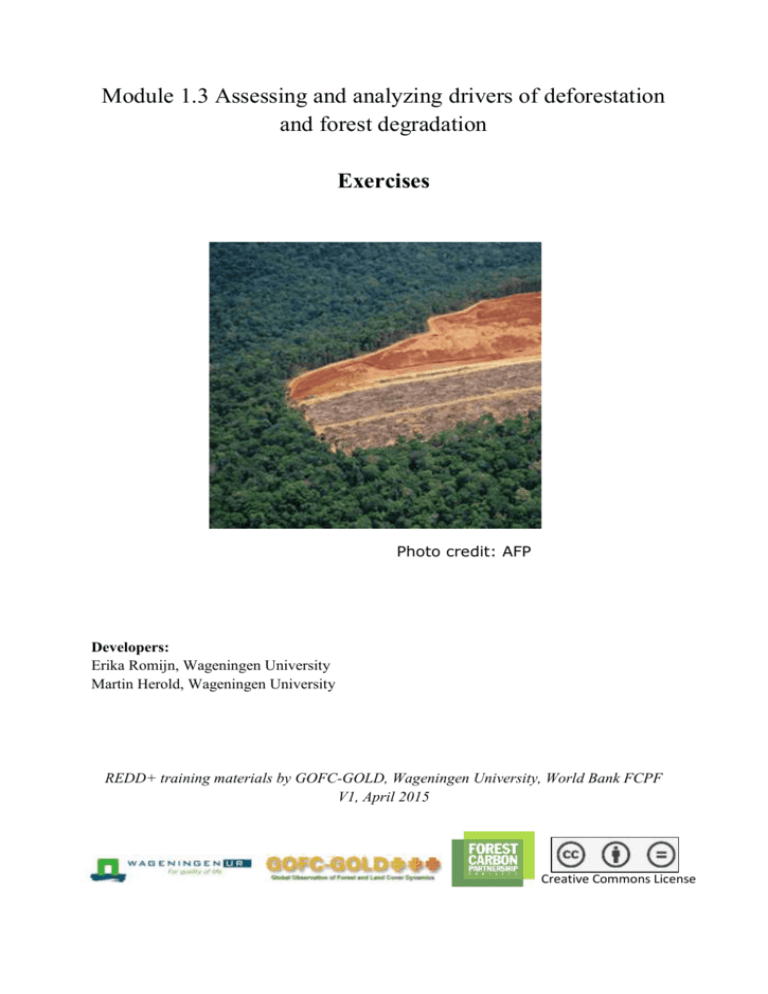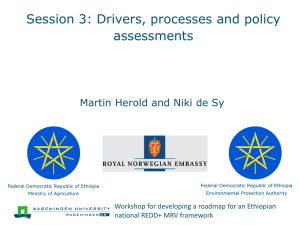Exercises - The Forest Carbon Partnership Facility
advertisement

Module 1.3 Assessing and analyzing drivers of deforestation and forest degradation Exercises Photo credit: AFP Developers: Erika Romijn, Wageningen University Martin Herold, Wageningen University REDD+ training materials by GOFC-GOLD, Wageningen University, World Bank FCPF V1, April 2015 Creative Commons License Exercises Module 1.3 Assessing and analyzing drivers of deforestation and forest degradation Assessing and analyzing drivers of deforestation in a tropical country Introduction Within the UNFCCC REDD+ program, developing country Parties are requested, when developing and implementing their national strategies or action plans to address the drivers of deforestation and forest degradation. Drivers of deforestation and forest degradation have many causes, and actions to address these drivers are unique to a countries’ national circumstances, capacities and capabilities. Climate change mitigation policies for REDD+ are based on addressing the drivers of deforestation and forest degradation and aim at reducing the emissions that are associated with these drivers. The particular drivers in a country determine what kind of monitoring approaches are needed to track them and are key to define monitoring priorities and appropriate methods for MRV. By tracking forest activities over time, a country can follow the impact of different drivers on deforestation. Another important aspect of monitoring drivers is that GHG emissions can be attributed to the specific causes. These need to be reported in the GHG inventory of a country. It also provides information on the impact of different drivers on the carbon budget and shows the priorities for addressing drivers. The country examples of DRC and Indonesia in this module showed different strategies and options to monitor drivers of deforestation and forest degradation. There are two types of methodologies to assess the drivers: 1. Qualitative assessment In the case of DRC qualitative surveys and workshops were performed to analyse the different drivers and to assess the importance of these drivers for the country. This was done by interviewing experts, village chiefs, members of civil society, officials of provincial administrative services and actors in the formal sector. The outcome was a list of the most important drivers of deforestation and forest degradation in order of importance. 2. Quantitative assessment For the quantitative assessments, in both Indonesia and DRC, drivers of deforestation were analysed based on land cover changes by performing a time series analysis on different maps. Land cover maps were created based on classification of Landsat satellite data. For subsequent periods in time, deforestation and forest degradation areas were mapped. For the areas where deforestation was taking place, the post-forest land use was mapped. This gives quantitative information on the area of deforestation per direct driver in these areas. Assessing drivers in a tropical country The exercises presented here are general exercises which may be used in any country case. For these exercises, no spatial analysis with comparison of different maps will be made. These exercises are meant for country experts, to think of ways to address and monitor drivers of deforestation in their own country. Exercise 1 Strategy development on how to address drivers The purpose of this exercise is to think of a strategy on how to monitor drivers of deforestation and forest degradation in your own country. You can use the material presented in the lecture and country examples of this module as background information to develop your ideas on this. Possible methods include qualitative and quantitative assessments, as presented above and in the country examples. The following questions may guide the process for establishing a strategy: 1. Which drivers are active within the country? It may be important to differentiate between driver activity within the forest and outside the forest sector. Significant driver activity can also be active outside the forest sector (see lecture). 2. Where (at which institutions, in which databases) is the necessary information on drivers available? How can this information be gathered? 3. Are there already existing data and maps that can be used to analyse drivers of deforestation and forest degradation? 4. Which are the gaps that need to be filled in order to properly monitor drivers of deforestation and forest degradation? (information and data that need to be collected, maps that need to be created) 5. Which experts need to be approached? 6. How can the information and data be included in a drivers assessment? 7. What is the impact of different drivers on deforestation; what will be the monitoring priorities? 8. How can the assessment of historic and current drivers inform assessment of response measures or areas of future driver activity tracking? This is particularly important for anticipating future drivers and developing appropriate response measures. Based on your own knowledge, try to set up a strategy for monitoring the drivers of deforestation and forest degradation in your country. This can be discussed within the group. Exercise 2 Qualitative assessment of the drivers of deforestation Appendix I contains an example of an assessment of current active processes and drivers of forest carbon change in Fiji. These processes include the reduction as well as the enhancement of the forest carbon stocks. The purpose of this exercise is to perform a qualitative assessment of the drivers of deforestation in your own country. Based on your knowledge, try to list the most important drivers of deforestation and the actors involved in the forest change processes. Mention the effect of the driver on the forest carbon in the short and long-term, whether it is a carbon source or sink. Estimate the area per driver and the amount of CO2 emissions per driver. Use table 1 below, like in the Fiji example, to fill in the driver information that you already know. Reference Weaver, S., Herold, M., Payton, I., 2009. Fiji REDD Policy Scoping Report. Pacific-German Regional Programme Adaptation to Climate Change in the Pacific Island Region. Report prepared for GTZ/SPC by Carbon Partnership Ltd. Table 1. Assessment of current processes and drivers active in ... Current Drivers of Forest Carbon Change in ... Processes that effect Who is doing it Effects on the forest carbon stocks and for forest (carbon) what purpose in (historical, the short and current, long-term future) How important is the process nationally (area affected)? carbon impact Appendix I Assessment of current processes and drivers active in Fiji Source: Weaver, S., Herold, M., Payton, I., 2009. Fiji REDD Policy Scoping Report. PacificGerman Regional Programme Adaptation to Climate Change in the Pacific Island Region. Report prepared for GTZ/SPC by Carbon Partnership Ltd. Current Drivers of Forest Carbon Change in Fiji Processes that effect Who is doing it Effects on the forest carbon stocks and for forest (carbon) what purpose in (historical, the short and current, long-term future) Forest conversion for Landowners or Source (large) expansion of lessees agriculture (or of land biofuels) Conversion of forest Developers and Source for squatters (medium) settlement(squatters)/ tourism – especially in mangroves and including illegal settlements Plantation clear-fell Government owned Sink, if not harvesting & Forestry companies replacing native replanting forest (medium) How important is the process nationally (area affected)? carbon impact Large Very high (+) Large High (+) Large High (-) Medium (+) Contractors commissioned by the forest owners or local communities – driven by market demand and/or local need for wood in village Farmers & arsonists Generally a source but sustainable forest management would help to minimise the carbon impact (1-2) Low – SFM Low – for local use Source (2) Low to medium – mainly in the dry western zones – Medium (+) Forest clear-fell for mining prospects Protecting native forest for ecosystem services, etc. e.g. Sovi Basin Shifting cultivation – slash & burn – especially in dry areas Mining companies Source (3) Low Forest resource owners and Environment NGOs, drivers of ecotourism Local communities, increasing due to population growth and cash crops Neutral, avoided emissions (2) Medium Medium (+) Medium (+/-) Source (2) Low – more in isolated rural areas Some (+) Afforestation of Government Sink (2) Low Some (-) High intensity selective logging of native forests remains native Accidental burning that gets out of control & into forest Medium commercial talasiga land pine forest for wood/chip production Afforestation with teak Natural regeneration of expired agriculturally leased land Increased vulnerability to cyclone damage/ fires/landslides of degraded natural wet forest initiative to benefit people Private forest company, landowners/lessees planting an investment Landowner leaving land idle/fallow Sink (2) Low Some (-) Sink as long as the trees stand (2) Low Some (-) Quasi-natural process Source (1) Low Low (+)






